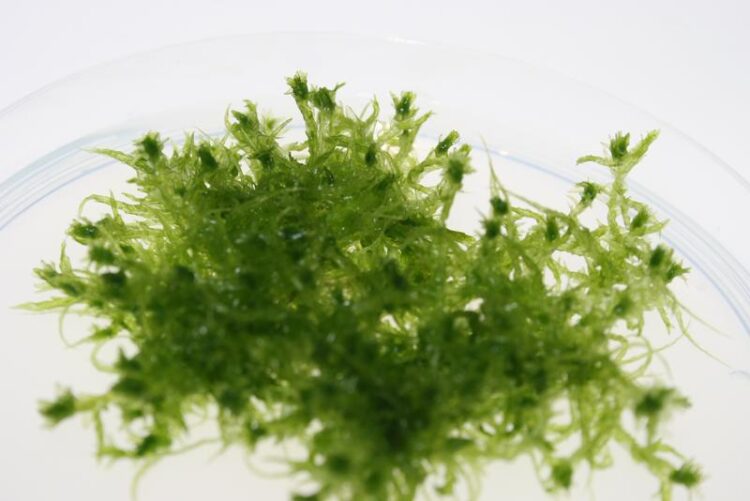Carbon Storage from the Lab

A lab strain of the peat moss Sphagnum centrale growing on solid medium.
Photo: Melanie Heck
Researchers at the University of Freiburg established the world’s largest collection of moss species for the peat industry and science.
Peatlands with their huge diversity of peat moss species store about 30 percent of the earth’s soil carbon. This means they store roughly twice as much carbon as all the world’s forests combined. However, peat harvesting and climate change are threatening these long-term carbon stores because there is not enough founder material for cultivating peat mosses on a large scale.
In collaboration with researchers from the University of Greifswald, a team of scientists led by plant biotechnologist Professor Ralf Reski from the Faculty of Biology of the University of Freiburg in Germany has established the world’s largest laboratory collection of mosses of the genus Sphagnum. With this as a foundation, peat mosses can be grown in a sustainable and economic way. The scientists have published their research in the scientific journal New Phytologist. Melanie Heck, a PhD student, is the first author.
For their project – called MOOSzucht – the scientists collected sporophytes, the spore capsules of mosses, of 19 Sphagnum species in Austria, Germany, Latvia, Russia, Sweden, and the Netherlands. The world’s largest collection of Sphagnum cultures is now housed in the International Moss Stock Center (IMSC), a resource center founded in 2010 at the University of Freiburg.
Scientists use the spores to create pure peat moss cultures in a laboratory environment that are not contaminated by bacteria, fungi, algae, or suchlike. Some species grow at a rate 50 to 100 times faster in the laboratory than in a moor landscape. The researchers measured the growth of the mosses in liquid mediums containing nutrients, also known as suspension cultures.
They also determined how many sets of chromosomes could be found in the cell nuclei in the cultures and compared this to the genome size of the already established model moss Physcomitrella patens. In this way they were able to identify haploid and diploid Sphagnum species – in other words, species with single or double sets of chromosomes, respectively. However, they could not find a correlation between the number of sets of chromosomes and moss growth, meaning it is still unclear why diploid mosses exist in nature.
Peat is harvested on a large scale for growing vegetables and ornamental plants in greenhouses and home gardens. Due to climate change and the resulting droughts and higher temperatures, peat mosses are showing poorer growth, deteriorating more quickly, and binding less carbon. The researchers from the University of Freiburg want to replace this dire need for peat with renewable biomass. However, the large amount of founder material that would be needed for this can only be produced in bioreactors. That is why Reski and his team at the IMSC are distributing lab strains of peat mosses to various research institutes and companies who are active in basic research, biotechnology, or in sustainable bioeconomy.
The MOOSzucht project, of which Reski’s plant biotechnology lab is a member, is a program funded by the German Federal Ministry for Food and Agriculture (BMEL) and runs from 2017 to May 2021. The project also includes two groups from the University of Greifswald, the Karlsruhe Institute of Technology (KIT), and the company Niedersächsische Rasenkulturen NIRA. In addition to his involvement in this project, Reski is a founding member of the excellence clusters CIBSS – Center for Integrative Biological Signalling Studies as well as livMatS – Living, Adaptive and Energy-autonomous Materials Systems, both of which are at the University of Freiburg.
Bildunterschrift
A lab strain of the peat moss Sphagnum centrale growing on solid medium. Photo: Melanie Heck
Original publication:
Heck M, Lüth VM, van Gessel N, Krebs M, Kohl M, Prager A, Joosten H, Decker E L, Reski R (2020): Axenic in-vitro cultivation of 19 peat-moss (Sphagnum L.) species as a resource for basic biology, biotechnology and paludiculture. New Phytologist. DOI: 10.1111/nph.16922
MOOSzucht Project
https://www.moorwissen.de/en/paludikultur/projekte/torfmooskultivierung/mooszuch…
International Moss Stock Center (IMSC)
https://www.moss-stock-center.org/
Article in Online Magazine
https://www.pr.uni-freiburg.de/pm-en/online-magazine/research-and-discover/again…
Contact:
Prof. Dr. Ralf Reski
Plant Biotechnology
Faculty of Biology
University of Freiburg
Germany
Phone: +49 (0)761 / 203 – 6969
Originalpublikation:
https://nph.onlinelibrary.wiley.com/doi/abs/10.1111/nph.16922
https://www.pr.uni-freiburg.de/pm-en/press-releases-2020/carbon-storage-from-the-lab?set_language=en
Media Contact
All latest news from the category: Life Sciences and Chemistry
Articles and reports from the Life Sciences and chemistry area deal with applied and basic research into modern biology, chemistry and human medicine.
Valuable information can be found on a range of life sciences fields including bacteriology, biochemistry, bionics, bioinformatics, biophysics, biotechnology, genetics, geobotany, human biology, marine biology, microbiology, molecular biology, cellular biology, zoology, bioinorganic chemistry, microchemistry and environmental chemistry.
Newest articles

An Endless Loop: How Some Bacteria Evolve Along With the Seasons
The longest natural metagenome time series ever collected, with microbes, reveals a startling evolutionary pattern on repeat. A Microbial “Groundhog Year” in Lake Mendota Like Bill Murray in the movie…

Witness Groundbreaking Research on Achilles Tendon Recovery
Achilles tendon injuries are common but challenging to monitor during recovery due to the limitations of current imaging techniques. Researchers, led by Associate Professor Zeng Nan from the International Graduate…

Why Prevention Is Better Than Cure—A Novel Approach to Infectious Disease Outbreaks
Researchers have come up with a new way to identify more infectious variants of viruses or bacteria that start spreading in humans – including those causing flu, COVID, whooping cough…



